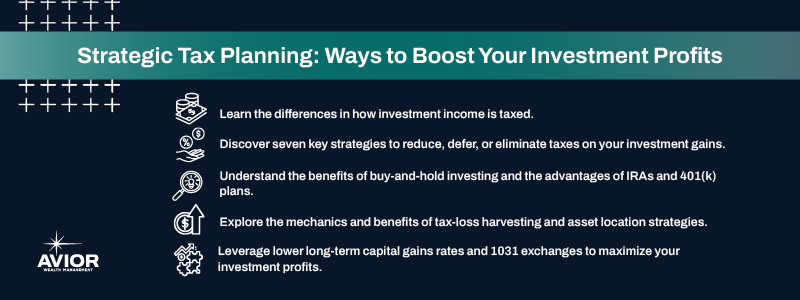Strategic Tax Planning: 7 Ways to Boost Your Investment Profits
Optimize your portfolio with these tax-efficient strategies to enhance returns and secure long-term financial success.

Protecting your investments from excessive taxation is crucial for achieving long-term financial success. Implementing strategies to reduce, defer, or even eliminate taxes on your investment gains ensures that more of your profits remain in your portfolio, working for you.
Here, we explore seven tax-efficient investing strategies designed to help you maximize your returns.
Understanding Taxation on Investments
Investment income is taxed differently by the Internal Revenue Service (IRS) compared to wages.
Key differences include the tax rates, timing, and manner of assessment. Generally, investments generate income in two ways:
- Capital Gains: Capital gains represent an increase in the value of an asset, such as stocks or real estate. The IRS taxes capital gains when they’re realized—meaning the asset has been sold for cash.
- Dividends or Cash Income: Dividends refer to money received throughout the year, typically subject to taxes in the tax year they are received.
Investors aiming to minimize taxes must navigate these rules effectively. Here’s how.
1. Practice Buy-and-Hold Investing
A foundational element of IRS tax law is the taxation of realized capital gains. In other words, this means that taxes are incurred only when an investment is sold.
Therefore, by holding investments indefinitely, you can defer taxes on gains indefinitely.
Additionally, research shows that passive investing tends to outperform active trading over the long term, providing higher returns while reducing tax liability.
The benefits of buy-and-hold investing include but are not limited to:
- Tax Deferral: Defers taxes on capital gains until the investment is sold.
- Higher Returns: Long-term passive strategies often yield better results than active trading.
- Reduced Costs: Fewer trades mean lower transaction costs.
2. Open an Individual Retirement Account (IRA)
IRAs are powerful tools for retirement savings, offering significant tax advantages.
There are two primary types of IRAs, each with its own distinct tax benefits:
- Traditional IRA: Contributions are made with pre-tax dollars, reducing your taxable income for the current year. Taxes on profits are deferred until withdrawal after age 59½.
- Roth IRA: Contributions are made with after-tax income, meaning no immediate tax break. However, your investments grow tax-free, and withdrawals are also tax-free after age 59½.
A traditional IRA is ideal if you expect to be in a lower tax bracket during retirement; a Roth IRA, on the other hand, is suitable if you anticipate a higher one.
Keep in mind that both types of IRAs have annual contribution limits and that the rules of each must be adhered to in order to avoid penalty taxes.
3. Contribute to a 401(k) Plan
Employer-sponsored 401(k) plans offer similar tax benefits to IRAs, with additional advantages.
There are two primary types of 401(k) plans:
- Traditional 401(k): Contributions are made with pre-tax dollars, reducing your taxable income. Taxes on earnings are deferred until withdrawal after age 59½.
- Roth 401(k): Contributions are made with after-tax dollars. Although there is no initial tax break, the account grows tax-free, and withdrawals are also tax-free.
401(k) plans, like IRAs, come with distinct advantages:
- Employer Match: Many employers match contributions, providing additional funds for retirement.
- Higher Contribution Limits: 401(k) plans typically allow higher annual contributions compared to IRAs.
- Flexibility: Both traditional and Roth options provide tax deferral and tax-free growth opportunities.
Also similar to IRAs, you should comply with your plan’s specific rules, especially regarding withdrawals, to avoid penalties.
4. Take Advantage of Tax-Loss Harvesting
Tax-loss harvesting involves selling investments at a loss to offset capital gains from other investments, reducing your taxable income.
The IRS allows you to write off investment losses against gains, so you’re taxed only on your net capital gain.
How tax-loss harvesting works:
- Offset Gains: Use losses to offset gains, reducing your taxable income.
- Carry Forward Losses: If losses exceed gains, you can carry them forward to future tax years.
For example, if you have a $10,000 gain on one investment and an $8,000 loss on another, you can offset them, resulting in a taxable gain of only $2,000.
You can offset up to $3,000 in net losses each tax year, with excess losses carried forward. You must also be aware of the wash sale rule to avoid repurchasing the same investment and voiding your ability to claim a loss within a 61-day period.
5. Consider Asset Location
Where you hold your investments significantly impacts your tax liability.
Dividends and other cash distributions are taxable in the year received, so strategic placement in tax-advantaged accounts is crucial.
An IRA, an example of a tax-advantaged account, defers taxes on dividend-paying stocks, while taxable accounts are suitable for holding growth stocks likely to trigger capital gains.
You should place your dividend stocks in tax-advantaged accounts to avoid immediate taxation. Growth stocks, on the other hand, should be held in taxable accounts to benefit from long-term capital gains tax rates.
You may want to consult with a financial advisor to help you determine whether placing all dividend-paying stocks in an IRA is the best financial move for your specific situation.
6. Utilize a 1031 Exchange
Real estate investors can defer capital gains taxes when selling one investment property by reinvesting the proceeds into another “like-kind” property with a 1031 exchange.
To qualify, the replacement property must be of equal or greater value, identified within 45 days, and purchased within 180 days.
This strategy benefits investors by allowing them to grow their wealth without immediate tax consequences, potentially leading to significant long-term savings.
7. Leverage Lower Long-Term Capital Gains Rates
The IRS taxes long-term capital gains at lower rates (0%, 15%, or 20%) compared to ordinary income, providing significant benefits for long-term investors.
The 0% capital gains tax rate applies if your taxable income is below specific thresholds, which, for 2024, are $47,025 for single filers, $94,051 for married couples filing jointly, and $63,000 for heads of households.
The 15% and 20% rates apply to higher income levels but are generally lower than ordinary income tax rates. The exact income levels at which these higher rates kick in depend on filing status and are subject to change.
To maximize the benefits of long-term capital gains rates, consider:
- Long-Term Holding: Hold investments for more than one year to qualify for lower rates.
- Income Management: Manage taxable income to stay within lower tax brackets.
A couple of example scenarios include:
- Lower Income Year: Realize gains in years with lower ordinary income to benefit from the 0% rate.
- Threshold Management: Plan investment sales to stay within favorable tax thresholds.
Enhance Investment Returns With Tax-Efficient Strategies From Avior
Employing tax-efficient strategies is essential for enhancing your investment returns by minimizing tax liabilities.
Leveraging tax-advantaged accounts like IRAs and 401(k) plans, combined with a buy-and-hold approach, can provide significant tax savings and investment growth. Understanding and utilizing the tax code effectively can ensure your investments continue to work towards your financial goals.
At Avior Wealth Management, helping you plan with intention is what we do, but helping you live with purpose is who we are.
Contact Avior Wealth Management today to schedule a consultation and explore these strategies further. Together, we can chart a course to a prosperous financial future.
Disclaimer: Nothing contained herein should be construed as legal or tax advice. Avior and our Advisors will work with your attorney and/or tax professional to assist with your legal and tax strategies. Please consult your attorney or tax professional with specific legal and/or tax questions. Investment Management and Financial Planner are offered through Avior Wealth Management, LLC, an SEC-registered investment advisor. Past performance is not a guarantee of future results. Investments are subject to loss, including the loss of principal.
No Comments
Sorry, the comment form is closed at this time.




